https://philaholisticclinic.com/dupuytrens-contracture-treatment/
Dupuytren’s contracture treatment
Dupuytren’s contracture treatment usually is not successful. Opposite this treatment is more palliative and aims to help patients cope with the symptoms of this disease. There is no cure for Dupuytren’s contracture. The condition is not dangerous. Many people don’t get treatment. But Dupuytren’s contracture treatment can slow the disease or help ease your symptoms.
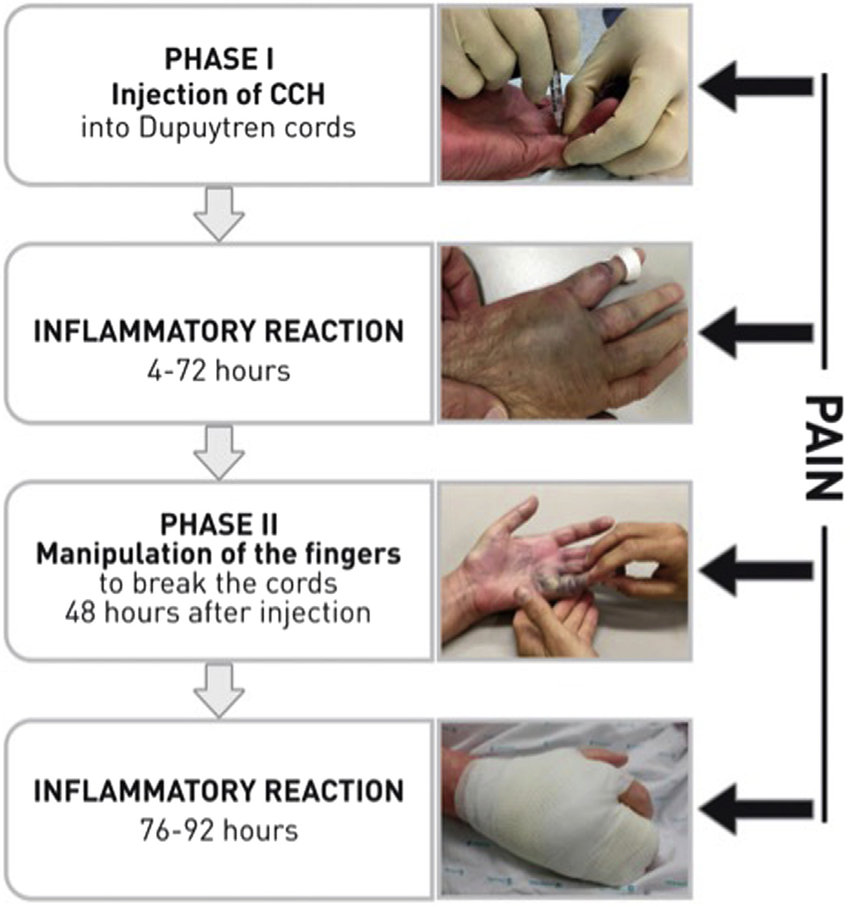
Dupuytren’s contracture treatment modalities may include:
Dupuytren’s contracture surgery
Dupuytren’s contracture surgery is the most common treatment used for advanced cases. It may be done when you have limited use of your hand. During Dupuytren’s contracture surgery, the surgeon makes a cut (incision) in your hand and takes out the thickened tissue. This can improve the mobility of your fingers. Some people have contractures return. They may need surgery again.
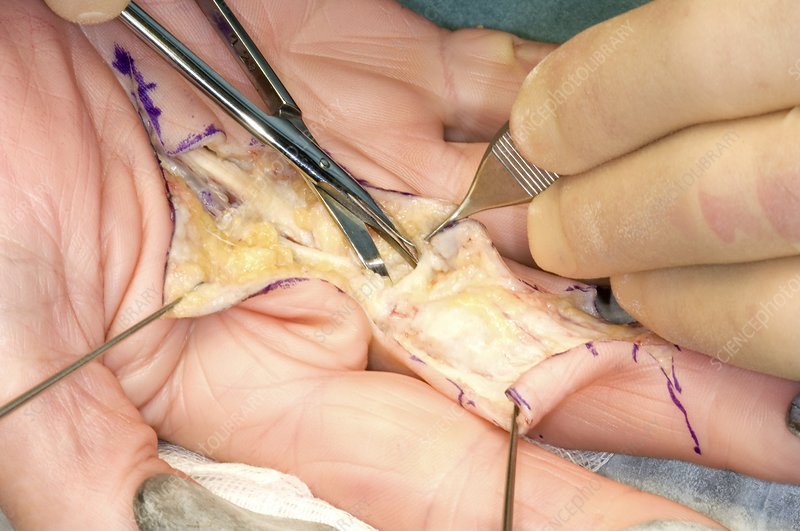
Steroid shot (injection) – another form of Dupuytren’s contracture treatment
If a lump is painful, a steroid injection may help ease the pain. In some cases, it may stop your condition from getting worse. You may need repeated injections.
Radiation therapy is not a very common but still a useful treatment
This treatment is not as common in the U.S. Low energy X-rays are directed at the nodules. This works best in the early stage of the disease. It can soften the nodules and help keep contractions from happening.
Enzyme injection as a form of treatment for Dupuytren’s disease
This is a newer, less invasive procedure done by specially trained surgeons. Your doctor injects a medicine into the area to numb the hand. Then the enzyme is injected into the lump of tissue. Over several hours, the enzyme breaks down and dissolves the tough bands. This lets the fingers straighten when the cord is snapped by the surgeon, usually the next day.
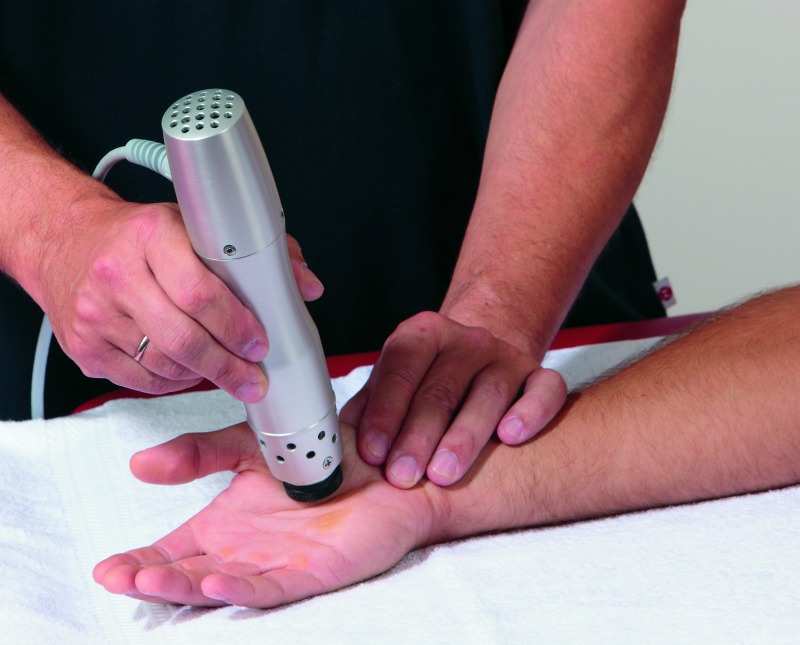
Needle aponeurotomy is less invasive than surgery but effective Dupuytren’s contracture treatment.
This is another newer, less invasive procedure. Medicine is injected into the area to numb the hand. The surgeon uses a needle to divide the diseased tissue. No incision is made.
What is Dupuytren’s contracture?
Dupuytren’s contracture (also called Dupuytren’s disease) is an abnormal thickening of the skin in the palm of your hand at the base of your fingers. This thickened area may develop into a hard lump or thick band. Over time, it can cause one or more fingers to curl (contract), or pull sideways or in toward your palm.
Dupuytren’s contracture causes thickening of tissues (fascia) in the palm. A fascia is a band or sheet of tissue beneath the skin.
If Dupuytren’s contracture progresses, one or more fingers bend (contract) into the palm and you cannot straighten the finger/s. The cause is not known. In many cases, it remains mild and does not require treatment. If the condition becomes more severe or the function of the hand becomes affected then a specialist may recommend Dupuytren’s contracture treatment.
Dupuytren’s contracture is named after Baron Dupuytren’s who described the condition (and invented an operation for it) in 1831.
The ring and little fingers are most commonly affected. In many cases, it affects both hands. Rarely, feet may also be affected.
Symptoms of Dupuytren’s contracture
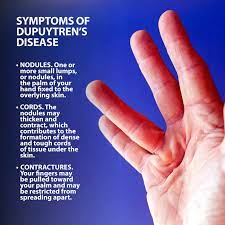
A Dupuytren’s contracture typically progresses very slowly, over a period of years. Common symptoms of Dupuytren’s contracture include:
- Not being able to lay your hand flat on a table, palm down (called the tabletop test)
- One or more small, tender lumps (nodules) in the palm. Over time, the tenderness usually goes away.
- The nodules may thicken and contract or tighten. This can cause thick bands of tissue under the skin in the palm of the hand.
- Pits or grooves in the skin compressed by the contracted finger. These areas can become very sore and can lead to skin loss if they don’t heal properly.
- Fingers are pulled forward
- Your hand is not able to work as well.
Other symptoms of Dupuytren’s contracture include:
Cords.
- The nodules may thicken and contract, contributing to the formation of dense and tough cords of tissue under the skin. These cords can restrict or tether the fingers and thumb from straightening or from spreading apart.
Contractures.
- As the tissue under the skin tightens, one or more of your fingers may be pulled toward your palm and may be restricted from spreading apart. The ring and little fingers are most commonly affected, but any or all of the fingers can be involved, even the thumb. Most commonly, the first joint (knuckle joint) of the finger is affected, but the other joints may also be involved.
As the bend in your finger increases, it may be hard to straighten it fully. It may be difficult to grasp large objects, put your hand in your pocket, or perform other simple activities.
Some patients with Dupuytren’s disease may develop thickened tissue on the feet (Ledderhose disease) or penis (Peyronie’s disease). Symptoms of Dupuytren’s contracture do not occur anywhere else on the body.
What causes Dupuytren’s contracture?
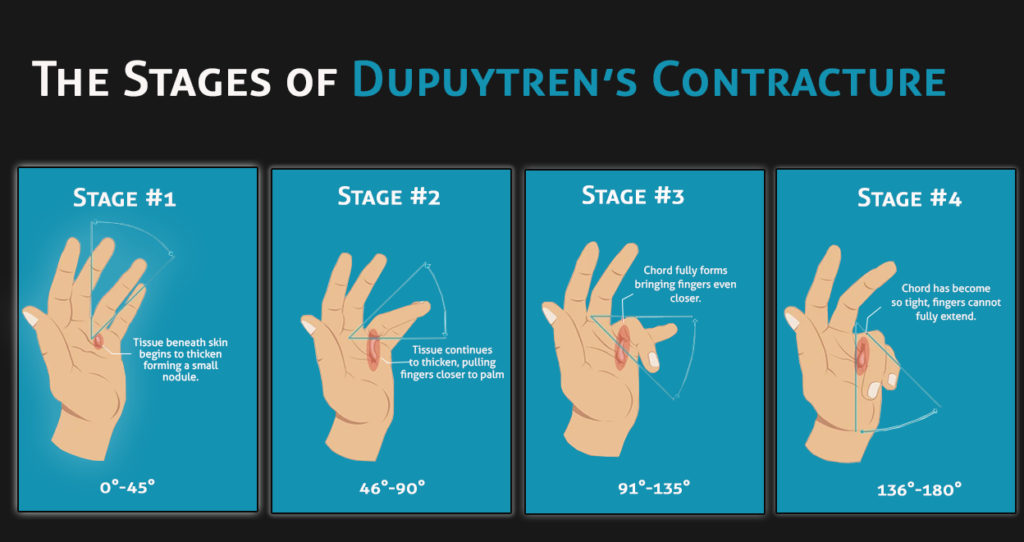
Dupuytren’s contracture is believed to run in families (be hereditary). The exact causes of Dupuytren’s contracture are not known. However, some of the possible causes of Dupuytren’s contracture are cigarette smoking, alcoholism, diabetes, nutritional deficiencies, or medicines used to treat seizures.
Who is at risk for Dupuytren’s contracture?
You may be at greater risk for Dupuytren’s contracture if you:
- Are older. The condition usually starts in middle age.
- Are male. It is more common in men than women.
- Have a Scandinavian or Northern European background. It is most common in people whose families come from these regions.
- Have a family history. The condition is often found in families, so it may be inherited.
- Take seizure medicine. It is linked with some medicines used to treat epileptic seizures.
- Smoke or abuse alcohol
- Have diabetes
Natural remedies for Dupuytren’s contracture treatment
Natural remedies for Dupuytren’s contracture treatment can help reduce the symptoms of Dupuytren’s contracture without causing any side effects. Listed below are the most common natural remedies for Dupuytren’s contracture treatment:
Home remedies for Dupuytren’s contracture treatment

Home remedies for Dupuytren’s contracture are natural remedies that are easy to use in the comfort of your home. Home remedies for Dupuytren’s contracture treatment are cost-effective and safe. Below are home remedies for Dupuytren’s contracture treatment:
Exercises for Dupuytren’s contracture
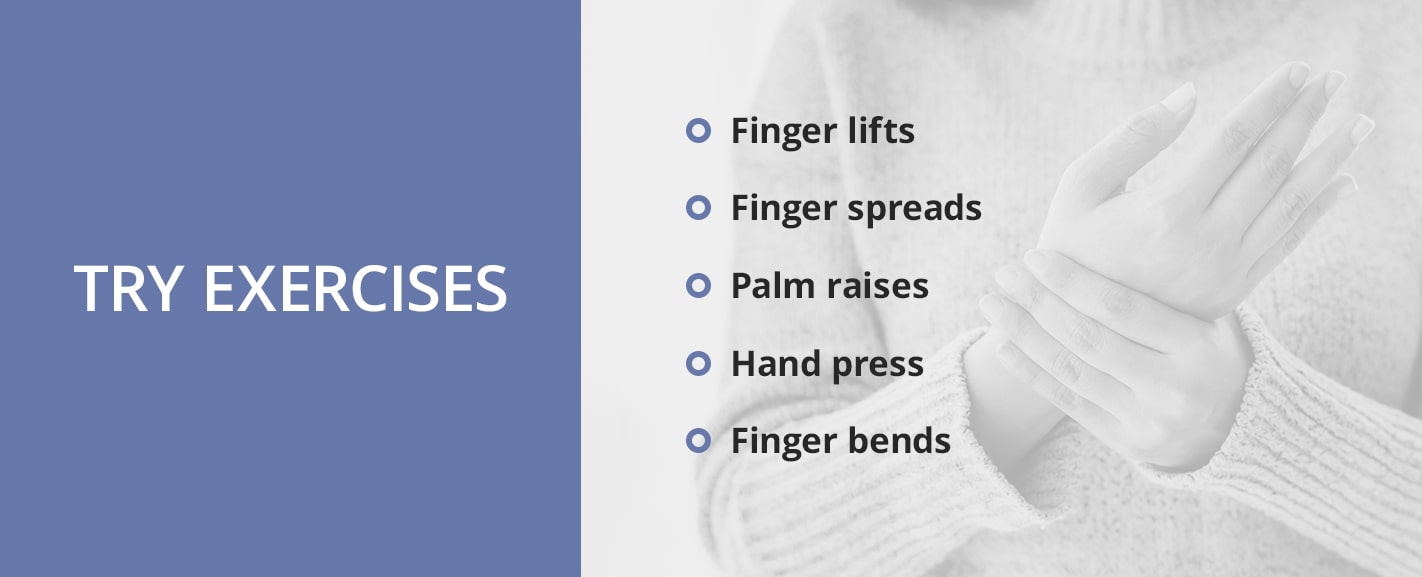
Exercises for Dupuytren’s contracture represent a modality of physical therapy for Dupuytren’s contracture that does help to increase ROM of the palm and fingers involved in contracture, and there are a number of exercises for Dupuytren’s contractive that you can do to help manage this condition. Exercises and stretches will not necessarily stop or slow the progression of the contracture, but they are helpful options during the early stages of Dupuytren’s disease:
- Finger lifts: In one of the simplest exercises for Dupuytren’s contracture. To achieve this, lay your palm flat on a smooth surface, like a table or desk. Next, practice raising each finger one at a time, pausing after each raise for a few seconds. You can repeat this exercise several times per day.
- Finger spreads: With your palm on a flat surface, you can also stretch your fingers by spreading them wide and drawing them back in together.
- Palm raises: Another exercise involves leaving your fingers flat on a surface while raising and lowering only your palm.
- Hand press: You can also try different exercises without a flat surface. First, place your hands in a prayer position. Then, gently push the palms and fingers of both hands together.
- Finger Bends: Another option is holding your hands in front of you, bending the first two joints of the fingers down, and straightening them.
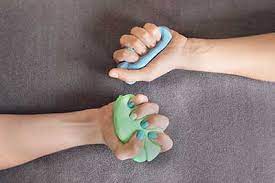
It’s important to remember to go easy on yourself. Stretching to the point of pain can do more harm than good. If the contracture has already begun on any of your fingers, you can use your other hand to push the fingers back into a straight position and hold for a few seconds. You can create an exercise routine and stretch the affected hands multiple times a day.
While gripping with high pressure is not a recommended approach to managing this condition, you can still practice the gripping motion. Picking up objects of different sizes and shapes can help maintain your grip strength and the dexterity in that hand. You can also practice gripping something soft, like a towel, to help maintain a grasping motion.
Massage – the most common treatment for Dupuytren’s contracture.
Massage is another home remedy for Dupuytren’s contracture treatment that is a good follow-up to exercise, but it can be beneficial as a standalone activity. You can conduct a gentle massage of the whole hand, including the palm and fingers, with your unaffected hand. Or, you can ask a family member or friend to lend their hands to the task.
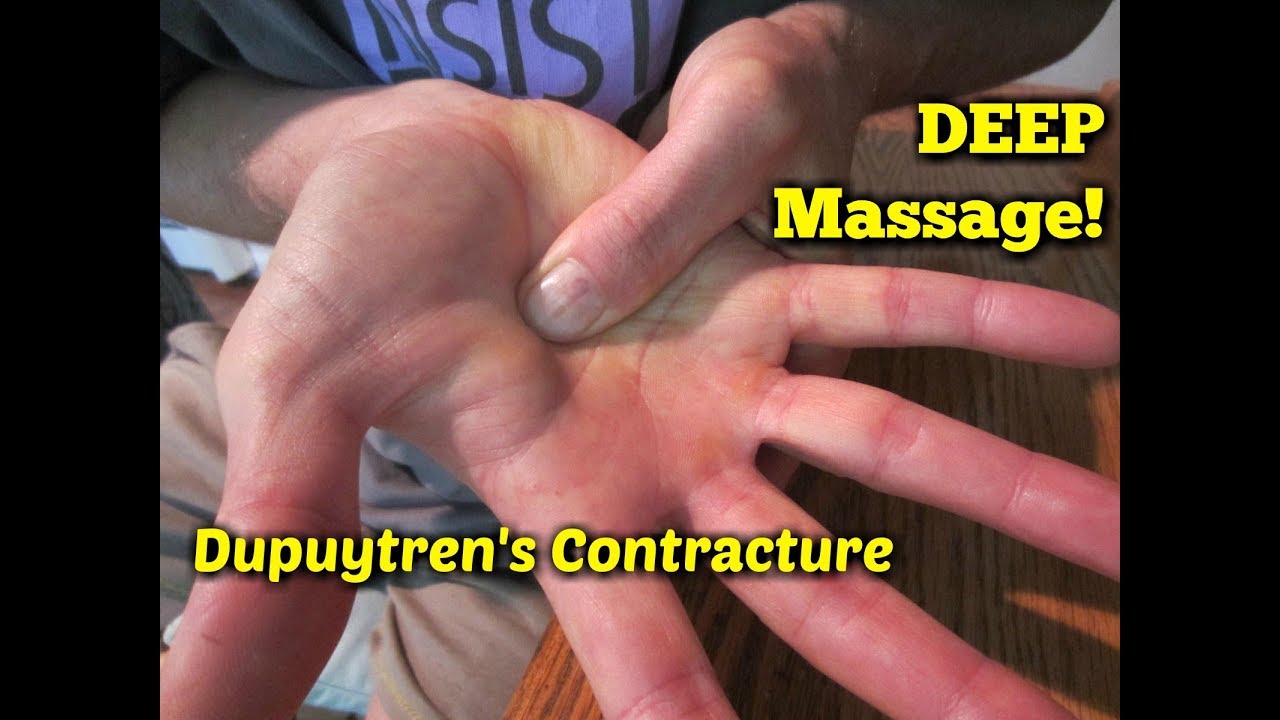
Remember to be gentle as you massage the hand. Rub the area including and around the thickening tissue of the palm, and work your way up to the fingers. You may be able to find a professional massage therapist with experience working with Dupuytren’s disease if you would like some outside help. When pursuing professional massage therapy, remember the earlier you get started the better. Massage is less likely to help your symptoms in the later stages of the disease.
Diet for patients with Dupuytren’s contracture
Diet is a very important home remedy for Dupuytren’s disease, it can actually help reduce the symptoms associated with Dupuytren’s contracture. If you are middle-aged or have a condition like diabetes — roughly 5% of people with Dupuytren’s contracture have Type 1 or Type 2 diabetes — your doctor has probably already talked to you about the importance of making healthy eating part of your life.
Once it becomes a habit, eating healthy may feel easy. But, if you aren’t sure where to start, it can take a little time to learn what works for your new meal plan. A healthy diet does not necessarily mean a boring or bland diet. It can vary widely from person to person. There are a few good rules to follow:
- Consider portion sizes: Whether you are having a main dish or a dessert, try to keep the amount you eat reasonably and listen to your body to eat to fullness.
- Look for whole and fresh foods: When it comes to selecting foods, try to opt for whole and fresh options. Try cooking with fresh vegetables instead of canned. Opt for fresh fruit instead of a canned fruit cocktail. Look for whole grains. These changes can help cut out unhealthy ingredients, such as sugars and preservatives.
- Reduce fat consumption: You can also opt for less fatty options of your favorite foods. Still enjoy dairy products, but go with the low-fat version. Still include meat in your diet, but look for healthier options. Try turkey burgers instead of beef burgers. Find new ways to cook lean meat, like chicken breast or fish.
- Consume anti-inflammatory foods: Foods eaten as a part of an anti-inflammatory diet may be a helpful consideration as well. These types of foods can include green leafy vegetables, fatty fish, fruits, and nuts.
Acupuncture for Dupuytren’s contracture
Acupuncture for Dupuytren’s contracture is a form of natural treatment for Dupuytren’s contracture that may provide a safe alternative to surgery Dupuytren’s contracture treatment as it is very effective.
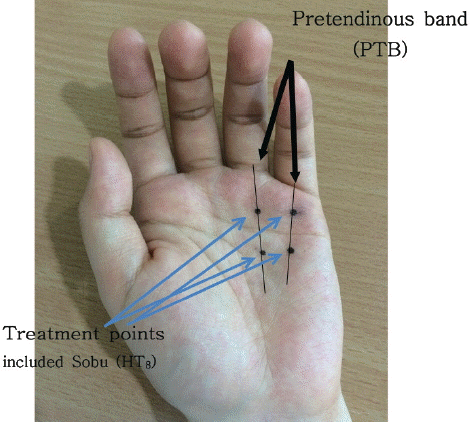
From a TCM point of view, the approach to Acupuncture for Dupuytren’s contracture treatment depends on which meridians are blocked and holding Qi energy from proper circulation. If the contracture occurs at the 4th finger then the heart and small intestine meridians are involved. Chinese medicine says that the liver plays a role in the health of the ligaments and tendons.
Western medicine has also observed a connection between the liver and Dupuytren’s contracture so acupuncturists use liver and sometimes gall bladder points to help moisten and soften tight ligaments and tendons. In fact, many athletes prefer acupuncture for Dupuytren’s contracture treatment as they feel it makes them more supple and loose and hence prevents injuries.
Homeopathy for Dupuytren’s contracture treatment
Homeopathy for Dupuytren’s contracture is one of the most effective natural treatments for Dupuytren’s contracture that causes no side effects.

Below are homeopathic remedies for Dupuytren’s contracture
- Silicea – Homeopathic Medicine for Dupuytren’s Contracture with Pain on Finger Movement
- Causticum – Homeopathic Remedy for Late Stages of Dupuytren’s Contracture
- Ruta – Natural Homeopathic Medicine for Dupuytren’s Contracture with Nodes on the Palm of Hand
- Colocynthis – Natural Homeopathic Remedy for Dupuytren’s Contracture with Pain in Palms
- Rhus Tox – Natural Medicine for Dupuytren’s Contracture with a History of Injury to the Hand
Treatment for Dupuytren’s disease in Philadelphia
Philadelphia Holistic Clinic is the #1 integrative medical facility in the Citi of Brotherly Love. Under the supervision of Victor Tsan, MD, the team of licensed practitioners perform different forms of holistic treatment for Dupuytren’s contracture including acupuncture, homeopathy, reiki, medicinal herbs, and more.
Contact Philadelphia Holistic Clinic (267) 403-3085 to schedule an appointment with Dr. Tsan for evaluation and treatment.
Comments
Post a Comment